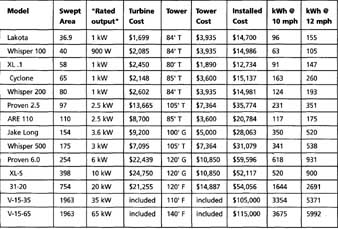Like a good sales person, I’ve given you the scoop on wind power before I drop the cost bomb, How much does it cost to install a wind machine.
As noted earlier, wind generators for household use vary from the smallest 1,000- watt machines to the largest 20,000-watt unit. If you simply want to supplement your electrical energy from the grid, a wind machine of 1,000- to 3000-watt rated output might be ideal, When buying, look for models in this range, then compare them using swept area, weight, kwh per month at different wind speeds, and costs — notably, cost per square foot of swept area and cost per unit of weight. A 1,000- to 3,000-watt wind generator might also work if you live in a tiny cabin or you are extremely efficient, and it might suffice if you are installing a hybrid system — a combination of wind and PVs — or some other renewable resource such as micro-hydro-electric.
If you want to go off-grid completely and are hoping to supply electricity solely from a wind machine, you’ll very likely need a larger wind generator — a machine with a rated power output of more than 3,000 watts but more likely 6,000 watts or higher. Again, what ever you do, be sure to make your home as efficient as possible in its use of electricity first, As I’ve said before, small investments in electrical efficiency pay huge dividends by reducing system size and costs.
Also, remember that you get what you pay for. Heavy-duty wind machines generally cost more but are more durable and will very likely outlast their cheaper, lighter, high-speed cousins, A good heavyweight wind turbine will very likely last 20 years or more. Its light weight cousin will last half that time, maybe even only one-fourth as long, according to Cabrillo. So savings on a less expensive model are eaten up by replacement costs,
Another important consideration when designing a wind system is that tower height makes a huge difference in power output. Because power increases dramatically with wind speed and because wind speed increases with height, raising the tower a bit can greatly boost a system’s output. So rather than paying twice as much to purchase a more powerful wind machine, consider a smaller investment in tower height to increase energy production.
Wind machine costs vary tremendously, ranging from $1.50 to $5.50 per watt of rated output, depending on the manufacturer, Wind machines around 1,000 watts rated output cost about $1,600 to $2,500 with a charge controller, although there are some models in this range that cost more than $5,000, Wind machines ranging from 2,500 to 6,500 watts with charge controllers will run about $7,000 to $14,000, Costs for the largest residential wind machines — 8,500 to 20,000 watts rated output — fall within the range of $20,000 to $36,000.
But don forget the tower, another big expense. Tower prices vary considerably, depending on the height of the tower, type of tower (monopole vs. guyed tilt up, for instance), and type of material. You can pay as little as $2,500 for a fairly short tower (43 feet), way too short for most applications, to $56,000 for a very tall (140 foot) and sturdy monopole tower,
But that’s not all. You may need to install a concrete base for your tower. Electric wiring and supplies need to be added to the cost. and then there’s installation costs if you’re hiring a professional installer, Remember, too, that tall towers need to be grounded to protect them against lightning strikes. This will add a little expense, too.
You will also very likely need an inverter, unless you’re buying an AC wind machine, in which case the inverter comes with the turbine, and if you are installing a grid-connected sys tem with battery backup or a stand-alone system, you’ll also need a battery bank. An inverter could run you $2,000 to $3,000 and a battery bank could easily cost $2,000 or more, depending on its size. See Table 8-2 for the total cost of installing several different wind systems.
When calculating costs and trying to deter mine whether wind makes financial sense, remember that a number of states and utilities and even some local municipalities offer financial incentives to cut initial costs. These include tax credits, property tax exemptions, low-interest loans, and rebates. They are discussed in here.
Remember, too, that on grid-connected systems surplus electrical energy can be sold back to power companies. Again, rather than repeat what I’ve said in Section 7, I refer you to that material.
Table of Typical Prices for Installed Systems (circa 2007)

Next: Wind Power without Installing a Wind Generator